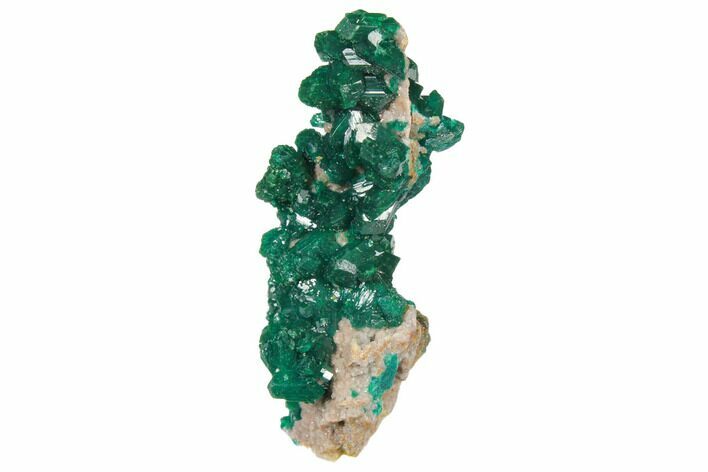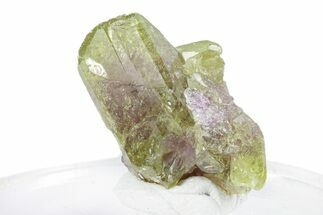This Specimen has been sold.
1.9" Gemmy Dioptase Cluster on Dolomite - Ntola Mine, Congo
This is a very nice cluster of dioptase crystals from the Ntola Mine of the Republic of Congo. The entire specimen is 1.9" tall and the lustrous, rich green crystals reach up to about .3" long. They have a saturated, dark emerald-green color with well defined crystals, all atop a dolomite encrusted matrix.
The dioptase cluster has been mounted to an acrylic display stand.
The dioptase cluster has been mounted to an acrylic display stand.
Dioptase is an uncommon mineral, found mostly in desert regions where it forms as a secondary mineral in the oxidized zone of copper sulfide mineral deposits. This copper-based mineral forms small rhombohedral crystals, typically less than 0.75 centimeters in length. It is popular with mineral collectors due to its vibrant color and it is occasionally cut into small emerald-like gems.
Dolomite is an anhydrous carbonate mineral composed of calcium magnesium carbonate (CaMg(CO3)2).
The mineral dolomite crystallizes in the trigonal-rhombohedral system. It forms white, tan, gray, or pink crystals. Dolomite is a double carbonate, having an alternating structural arrangement of calcium and magnesium ions. It does not rapidly dissolve in dilute hydrochloric acid as calcite does. Crystal twinning is common.
Dolomite was first described by Carl Linnaeus in 1768, and in 1791 it was described as a rock by the French naturalist and geologist Déodat Gratet de Dolomieu. He first recognized the material in buildings of the old city of Rome, and later as samples collected in the mountains known as the Dolomite Alps of northern Italy.
The mineral dolomite crystallizes in the trigonal-rhombohedral system. It forms white, tan, gray, or pink crystals. Dolomite is a double carbonate, having an alternating structural arrangement of calcium and magnesium ions. It does not rapidly dissolve in dilute hydrochloric acid as calcite does. Crystal twinning is common.
Dolomite was first described by Carl Linnaeus in 1768, and in 1791 it was described as a rock by the French naturalist and geologist Déodat Gratet de Dolomieu. He first recognized the material in buildings of the old city of Rome, and later as samples collected in the mountains known as the Dolomite Alps of northern Italy.
SPECIES
Dioptase & Dolomite
LOCATION
Ntola Mine, Mindoili District, Republic of Congo
SIZE
1.9 x .95"
CATEGORY
ITEM
#130498
 Reviews
Reviews















